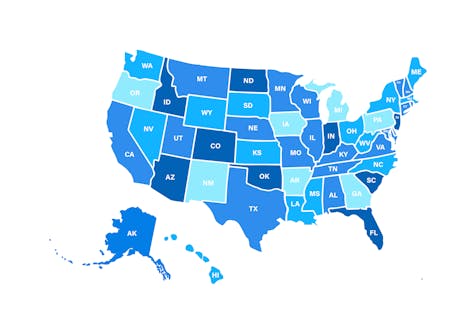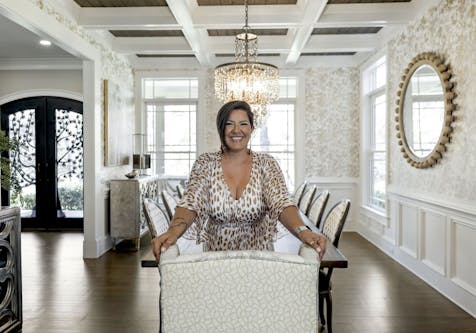Can You Call Yourself an Interior Designer Without a License?
Depending on where you live, you may need a license to call yourself an interior designer. Learn which states require a license from the experts at Houzz Pro

It might come as a surprise that in the majority of states anyone can call themselves an interior designer, regardless of education, training and licensure, as there is no legal certification required. This doesn’t mean you shouldn’t consider obtaining a license or getting a specific qualification, it just means it’s not a must-have to become an interior designer. And while licensing may not be necessary in most states for designers working in residential properties, there are a few states that require interior designers to be registered to work unsupervised in commercial spaces, such as hotels and restaurants.
Do you have to be licensed to be an interior designer?
Despite licensing not being a legal requirement for interior designers in most areas, there are over 20 states that offer interior designers the option to obtain a license through a rigorous examination process, to show they meet high standards of practice. In fact, for many interior designers, obtaining a certification is one of the many levers they can pull to demonstrate their professionalism, experience and to stand out from the crowd. In a recent survey conducted by Houzz in 2022, it was discovered that more than 3 in 5 interior designers in the U.S. hold a license or a certification, suggesting that obtaining a license was an important factor when setting up their business.
Here we dive deeper to answer the question “can you practice interior design without a license?”, determining the states that require licensing and those that don’t, so you are clear on the requirements of your location. Click on a link to jump straight to the section you're most interested in:

States where you have to be licensed to be an interior designer
In the US and Canada, interior design is regulated through different types of laws, one of which is known as a practice act, requiring people to meet a certain professional standard in order to practice interior design. A practice act also requires an individual to have a license in order to call themselves an interior designer.
Licensing requirements differ from state to state, however, in most cases, to achieve a license, an interior designer must meet certain education, experience and examination conditions. They must also be registered with the necessary interior design board in that state.
Below is a list of states that have practice acts, as well as each state’s licensing requirements:
- Alabama - The Albama Board for Registered Interior Designers (ABRID) offers public protection through examination and certification. Certification by ABRID is the highest standard of professionalism for interior designers in the State of Alabama.
- Florida - In Florida, you need to be a registered interior designer to work in commercial buildings, such as hotels, restaurants and offices. Work in Commercial properties requires registration by the Board of Architecture and Interior Design.
- Nova Scotia - You can only use the title of ‘interior designer’ if you are registered as a member of the Interior Designers of Nova Scotia (IDNS), a professional association of interior designers.
- Puerto Rico - You must be licensed through the Puerto Rico State Department Examining Board of Interior Designers to use the title as well as practice interior design, particularly if you wish to work unsupervised in any commercial space.
- Louisiana - It is mandatory to become a Louisiana registered interior designer if you want to practice the profession and work in commercial buildings, like schools and offices.

States that have title laws for interior designers
A title act regulates whether you can add “registered” or “certified” to your title depending on what state you're in. The goal of a title act is to ensure interior designers meet the minimum standard of education, experience and examination that’s required in that state, so clients can feel reassured they are employing a qualified and knowledgeable professional. Despite this reassurance, title acts do not require interior designers to obtain a license in order to practice.
Below is a list of states that have title acts:
- Texas
- Ontario
- Minnesota
- Georgia
- Alberta
- Saskatchewan
- British Columbia
- Manitoba
- Quebec
- Maine
- New York
- Virginia
- Kentucky
- Tennessee
- Mississippi
- Indiana
- Illinois
- Missouri
- Arkansas
- Oklahoma
- Iowa
- Wisconsin
- New Mexico

States where you can call yourself an interior designer without a license
A state with self-certification, doesn’t have any professional board overseeing the profession, and therefore it is left entirely up to the individual as to whether they obtain a nationally-recognized certification.
Despite no license being necessary in some states, it’s essential an interior designer gains the training and experience necessary to create functional and aesthetically pleasing spaces that fulfill a client’s brief.
Below is a list of states with self-certification laws, which do no require licensure or offer registration to become an interior designer:
- Washington
- Idaho
- Montana
- Oregon
- Wyoming
- North Dakota
- South Dakota
- Nebraska
- Kansas
- Colorado
- Michigan
- Ohio
- West Virginia
- Pennsylvania
- South Carolina
- Delaware
- Vermont
- New Hampshire
- Massachusetts
- Rhode Island

Additional interior design licensing FAQs
What’s the difference between interior design practice laws and titling laws?
Practice laws are in place in some states to ensure an individual obtains a license to practice their profession. A title act ensures an individual meets that state’s required standard of education and examination to advertise themselves as a ‘registered’ or ‘certified’ interior designer. A title act doesn’t, however, require an individual to be licensed to practice the profession, yet both practice and title laws aim to raise the public awareness of the professionalism and education of the interior designers in that state.
What does it mean to have permitting privileges?
New builds, major remodels and structural additions will generally need to obtain a building permit, and this is usually submitted to the city planning department by the architect, and not usually by the interior designer. However, some states grant interior designers authority to submit these plans for approval, and this is known as having permitting privileges.
Do licensed interior designers earn higher salaries?
According to a 2022 survey by Houzz, designers with a license or certification made $100,000 or more in gross revenue last year than those without such credentials; only 59% of those without a license or certificate related to interior design earned that much in 2021. This potentially indicates that in the long run, interior designers with a license are likely to make more in revenue than those without. However, there is an ongoing debate on this topic, as every individual experience will be different.
Read How Much Do Interior Designers Make? to learn more
While a third of interior design companies* make less than $100,000 in annual revenue, Houzz State of the Industry study finds that annual revenue for more than 7 in 10 interior design businesses was more than $100,000. That said, the study also finds that a typical project undertaken by an interior designer is about $25,000 or more.
*Note that 90% of interior design companies have either 4 or less employees and 41% have no employees at all.
What are the requirements to be an interior designer?
Not only do you need to have a passion to make people’s lives easier and better, whether that’s by redesigning their homes, places of work, or the leisure spaces they use, you also need to have design skills, attention to detail and client facing aptitude. To become a certified, registered or licensed designer, depending on the state you live in, an interior designer needs to meet certain education, experience and examination requirements. A common route is to earn a degree followed by the NCIDQ exam, which establishes standards of competence in interior design.
Now read The Ultimate Guide to Interior Design Certification to find out more useful information.

Conclusion
While being licensed isn’t a necessity in the majority of states in order to practice the profession, with a recognized license or certification, an interior designer demonstrates they are educated to a high standard, have the skills needed to do the job, and also have the knowledge of industry standards. Obtaining a license creates confidence between you and the client, differentiates you from your competition, and gives you more earning power, as well as opportunities to work on commercial projects.

Want advice delivered to your inbox?
Unlock industry insights and updates for contractors and design pros
By signing up, I agree to the Houzz Terms of Use and Privacy Policy and that Houzz may use my information to contact me about relevant content, products, and services.














Join the conversation by commenting or asking a question below. The Houzz team reads every single comment, and we’ll get back to you by email if you need us!